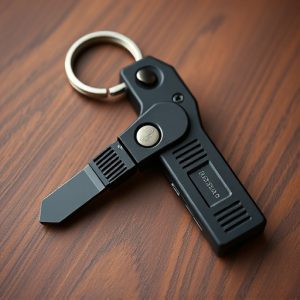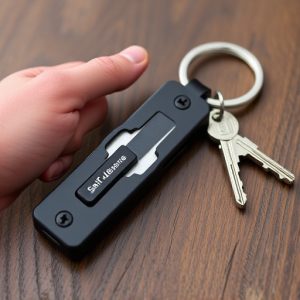Designing Effective Compact Keychain Self-Defense Tools: Metal Grip Tips
Compact Keychain Self-Defense Tools are popular for personal safety due to their convenience, effect…….
Compact Keychain Self-Defense Tools are popular for personal safety due to their convenience, effectiveness, and ease of deployment. Designers must balance functionality, strength, and ergonomic grip. High-strength metals like alloys or specialized steels offer durability and corrosion resistance. Ergonomic designs ensure comfort and discreet accessibility, with tactical features enhancing deterrence. Rigorous testing and user feedback are crucial for refining the design, ensuring sturdiness, reliability, and ease of use in unexpected situations.
Discover the secrets behind creating an effective compact keychain self-defense tool. This guide explores key aspects of design, from selecting the right metal for grip comfort and durability to incorporating powerful defense mechanisms. Learn how ergonomics play a crucial role in ensuring your keychain is not only functional but also easy to use. We’ll walk you through testing and refining your design to make it a reliable, portable self-defense solution.
- Understanding Compact Keychain Self-Defense Tools
- Choosing the Right Metal for Your Keychain Grip
- Ergonomics and Comfort in Design
- Incorporating Effective Defense Mechanisms
- Testing and Refining Your Metal Keychain Grip Design
Understanding Compact Keychain Self-Defense Tools
Compact Keychain Self-Defense Tools have gained immense popularity due to their convenience and effectiveness in emergency situations. These tiny devices pack a punch, offering users a quick and accessible means of defense. Understanding the unique design considerations for such tools is essential when creating an efficient compact keychain self-defense option. The primary focus should be on functionality, ensuring that every component serves a purpose and contributes to the overall effectiveness during use.
Designers must consider factors like ease of deployment, strength, and ergonomic grip. A well-designed compact keychain defense tool should deploy smoothly yet securely, allowing users to grasp it firmly in their hand. The material choice is critical; high-strength metals are preferred for durability and longevity. Additionally, a thoughtful grip design improves control, making it easier to manage the tool during intense situations, ensuring users can defend themselves with precision and confidence.
Choosing the Right Metal for Your Keychain Grip
When designing a compact keychain self-defense tool, selecting the appropriate metal for the grip is a critical decision. The right metal can enhance both the functionality and durability of your keychain, making it an effective defense mechanism on-the-go. Look for metals that offer a good balance between strength and lightweight properties, ensuring ease of carrying without adding excessive weight to your keys or pouch.
Consider materials like high-strength alloys or even specialized steels designed for such applications. These can provide the necessary bite and grip for comfortable handling during an emergency. Additionally, some metal options offer corrosion resistance, which is vital for longevity, especially if your keychain is exposed to varying environments, ensuring your self-defense tool remains reliable over time.
Ergonomics and Comfort in Design
When designing a compact keychain self-defense tool, ergonomics and comfort should be top priorities. The device should fit comfortably in the hand, allowing for easy grip and control during use. This means incorporating ergonomic features like non-slip grips or textured surfaces that enhance dexterity and reduce fatigue, especially if the user needs to employ the tool in stressful situations. Comfortable design also ensures the keychain is more likely to be carried consistently, increasing its potential for real-world self-defense scenarios.
Additionally, compactness plays a crucial role in ergonomics. The keychain should pack powerful defensive capabilities into a minimal form factor without sacrificing functionality or ease of use. This balance allows users to keep their self-defense tool readily accessible and discreetly attached to their keys, ensuring they have peace of mind knowing they’re prepared for unexpected situations.
Incorporating Effective Defense Mechanisms
When designing a compact keychain self-defense tool, integrating effective defense mechanisms is paramount. These tools should offer more than just portability; they need to provide users with reliable and readily accessible means of protecting themselves in various situations. Incorporating features like sharp edges, durable materials, and ergonomic designs ensures that the keychain can serve as a potent defense mechanism. The compact size allows for discreet carrying, enabling individuals to stay prepared without compromising their style or comfort.
Effective self-defense mechanisms should also include tactical elements such as pepper spray or noise makers, which can deter potential threats and provide crucial seconds for escape. Additionally, considering the ease of use is essential; the keychain should be designed in a way that allows users to deploy it quickly and efficiently during emergencies. By combining compactness, durability, and strategic design elements, these keychains become practical and powerful tools for personal safety, making them indispensable accessories for modern individuals seeking peace of mind.
Testing and Refining Your Metal Keychain Grip Design
When refining your metal keychain grip design for self-defense tools, testing is paramount. Craft a prototype and subject it to rigorous trials—from gripping force assessments to durability tests under various conditions. Engage potential users in this process to gather valuable feedback on comfort, ease of use, and overall effectiveness. This iterative approach ensures that your final product excels as compact keychain self-defense tools should: sturdy, reliable, and easily accessible when you need it most.
Refine your design based on test results, considering factors like grip texture for improved control, weight distribution for balanced handling, and the overall aesthetic appeal to suit diverse user preferences. The goal is to create a seamless blend of functionality and form, transforming a small metal keychain into a powerful personal defense mechanism that users will feel confident carrying and using in unexpected situations.
When designing a compact keychain self-defense tool, it’s crucial to balance functionality, comfort, and durable materials. By incorporating effective defense mechanisms and refining ergonomics, you can create a powerful yet portable device. Remember that the right metal selection enhances grip and longevity, making your creation a reliable companion for personal safety. In terms of design, keep testing and iterating to ensure your compact keychain self-defense tool stands out as a game-changer in personal defense accessories.


